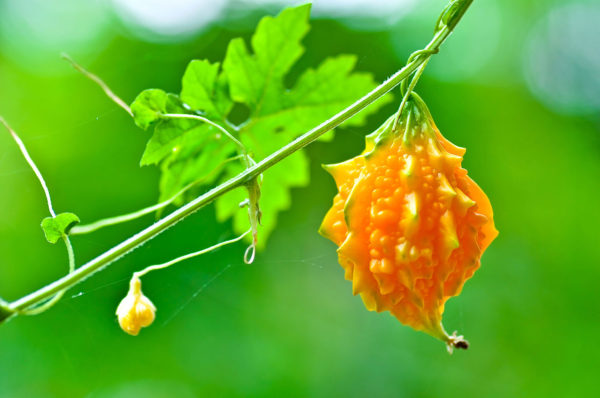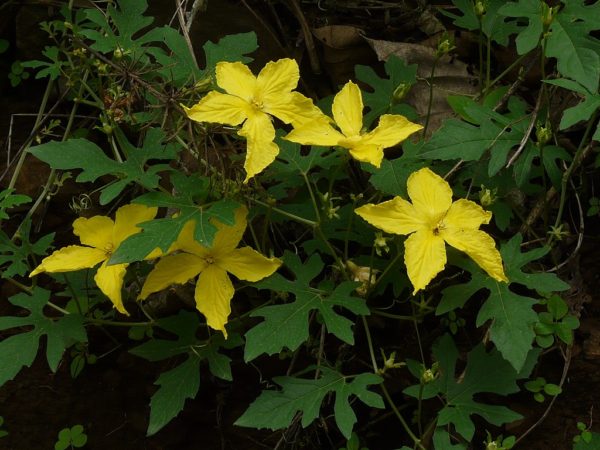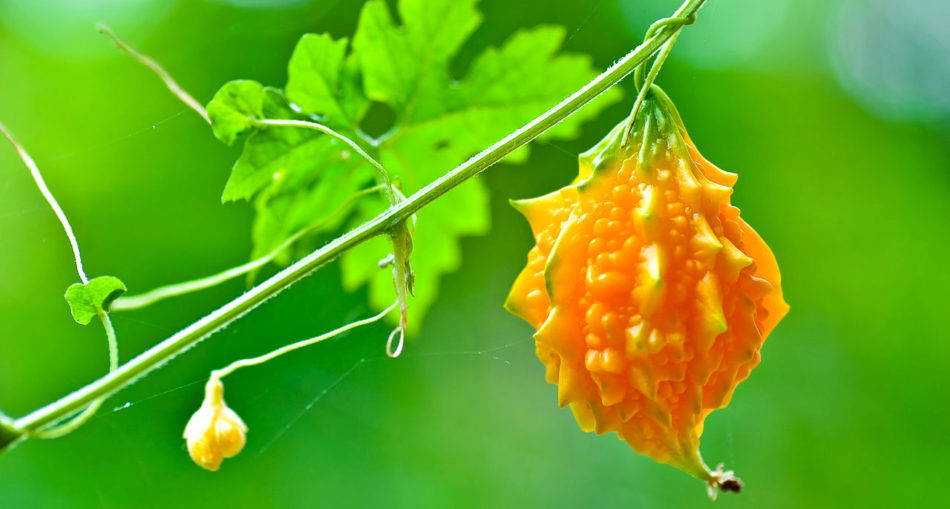Chances are if you have heard of karela, you know about ban karela – the round miniature, prickly version of karela. Like the karela, ban karela is also a fruit but is referred to as a vegetable by some. It is a climber or vine which means that it grows on fences and surrounding vegetation. It grows wild and in some countries is considered a weed. The scientific name for this plant is Momordica balsamina. Some other names for ban karela are bitter melon African cucumber, balsam apple. It is usually fried in Guyana and accompanied by meat, fish or shrimp. Ban karela leans to the sweeter side and it is much pleasing to the tastebuds.
Origin of Ban Karela
Ban karela is a popular fruit or vegetable depending on where you go and is even used as medicine. This plant originated in Africa and was introduced to the continent of Asia. Momordica balsamina can be found growing wild in Guyana, the Caribbean, Africa and countries in Asia, like India.

Ripe Ban Karela: Photo by: Balaram Mahalder [CC BY-SA (https://creativecommons.org/licenses/by-sa/3.0)]
Scientific Classification Of Karela
- Kingdom: Plantae
- Clade: Tracheophytes
- Clade: Angiosperms
- Clade: Eudicots
- Clade: Rosids
- Order: Cucurbitales
- Family: Cucurbitaceae
- Genus: Momordica
- Species: M. balsamina
Interesting Tip
- Momordica is a Latin word that means ‘to bite’, referring to the edges leaves of which look like they were bitten.
Description of Ban Karela
The ban karela is a perennial, climbing plant with stems three (3) to five (5) metres in size. It climbs on other plants or grows on the ground. The fruit is about two inches (2″) long and an inch (1″) wide with smooth prickly bumps on the skin. When it is green, the colours of the fruit vary from a light to a dark forest green. Ban karela is bright yellow and gets redder the closer it gets to ripening. The green leaves are broad, ovate, and deeply, triangularly lobed with sizes of three point eight to ten centimetres (3.8-10cm) by three point two to eight (3.2-8 cm). Small yellow flowers grow along these ban karela vines.

Karela flowers and leaves – Photo by Dinesh Valke from Thane, India [CC BY-SA (https://creativecommons.org/licenses/by-sa/2.0)]
Nutritional Information of Ban Karela
The leaves, fruits, seeds, and bark of the plant contains resins, alkaloids, flavonoids, glycosides, steroids, terpenes, cardiac glycoside, saponins. There are seventeen amino acids found in the fruit e.g. isoleucine, leucine, lysine, methionine, cysteine, phenylalanine, tyrosine, threonine, valine, alanine, arginine, aspartic acid, glutamic acid, glycine, histidine, proline and serine. Isoleucine, leucine, valine and aromatic acids are also found in the plant. The leaves contains Potassium (1,320.00mg), Sodium (122.49mg), Calcium (941.00mg), Magnesium (220.00mg), Phosphoros (130.46mg), Iron (60.30mg), Copper (5.44mg), Manganese (11.60mg) and Zinc (3.18mg).
Traditional Uses of Ban Karela
- Fruits – The fruits of ban karela treats a wide range of conditions such as inflammation, digestive disorders, haemorrhoids, and heart troubles. It is also used on chapped hands and feet, external sores, frostbite, and a laxative. In Syria, the fruits are used to heal wounds.
- Leaves – Leaves of ban karela treats fever and excessive uterine bleeding, syphilis, rheumatism, hepatitis and various skin disorders.
Other Uses
- Fruits – The fruits can be used as a substitute for soap.
- Leaf sap – This is said to be effective in cleaning metals.
Interesting Tip
- The Portuguese used the leaves to treat for diabetes, various digestive disorders, fevers, and malaria.
Health Benefits of Ban Karela
- Treats Diabetes – In some countries the fruits, leaves and roots of Momordica balsamina (ban karela) are used to treat diabetes. Studies have shown it maintains blood sugar levels.
- Lower cholesterol – Ban Karela lowers cholesterol levels in the body and reduces the risk of stroke and heart attack.
- Improves Skin and Hair – Due to the number of anti-oxidants contained this fruit, it reduces wrinkles and acne among other skin conditions.
Culinary uses of Ban Karela
- Fry – The fruits are lightly fried and the dish is especially delicious when paired with shrimps and rice.
- Curry – Ban karela can be made into a curry seasoned with plenty of spices.
- Steam – For a healthier, less fatty choice you can steam the green fruits.
Interesting Tip
- We typically eat the green ban karela but the full or half riped ones can be used in dishes too.
- The ripe seeds can be sucked but is not edible.
Ban Karela Curry Recipe
Ingredients
- 300 gm spiny gourd
- 1 large onion finely chopped
- 3 cloves garlic
- 2- tomato finely chopped
- 1 tsp turmeric powder
- 1 pepper
- 1 tsp ginger
- 1/2 tsp masala powder
- 1/2 tsp grind geera
- 1 tsp oil
- Salt (to taste)
Steps
- Slice ban karela fruits and wash thoroughly.
- Preheat pan and add 1 table spoon oil into it.
- Fry onion, garlic, grind geera, masala and turmeric powder
- Add the ban karela and tomatoes and fry until light brown.
- Add pepper and leave to cook for two (2) minutes.
- Serve with roti or rice.
Watch this! – Spiny Gourd Fry Recipe | Learn to Cook with Me
About Ban Karela
This wild fruit or vegetable is as popular as the karela (Momordica charantia) and contains as many nutrients. Ban Karela is the sweeter version of karela but still does its job to ‘bitter your blood’. There are several ways to cook ban karela, all of which ensure you benefit from better health after eating the fruit. The next time you get your hands on some ban karela, keep in mind one of the above recipes.
Article References
- https://en.wikipedia.org/wiki/Momordica_balsamina
- http://www.herbalafrica.co.za/momordica.html
- http://pza.sanbi.org/momordica-balsamica
- http://tropical.theferns.info/viewtropical.php?id=Momordica+balsamina
- http://citeseerx.ist.psu.edu/viewdoc/download?doi=10.1.1.545.6077&rep=rep1&type=pdf







